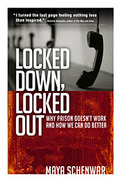

Maya Schenwar
USA
Contact Maya Schenwar
Maya Schenwar is the author of Locked Down, Locked Out: Why Prison Doesn't Work and How We Can Do Better, and is the Editor-in-Chief of Truthout, an independent social justice news website. She has written about the prison-industrial complex for Truthout, the New York Times, the Guardian, the Newark Star-Ledger, Ms. Magazine, and others, and has appeared on many national radio and television programs. She is the recipient of a Society of Professional Journalists Sigma Chi Award and a Lannan Residency Fellowship, both for her writing on prisons. Previous to her work at Truthout, Maya was Contributing Editor at Punk Planet magazine and served as media coordinator for Voices for Creative Nonviolence.
I know many people who are skeptical of prison reform, specifically the idea that there can be alternatives for dealing with people who commit particularly "evil" crimes. I feel like this book is one which will open skeptical minds and get them thinking. The skeptics will not be able to just dismiss this book as bleeding-heart liberalism... because it's a book that refuses to dodge the tough questions.
What do I mean by this? Well, the opening scene of the introduction describes the author's mixed feelings when her heroin-addicted sister ends up in jail, (again). The author writes, "Later, when I pick up the phone and hear a robotic voice announce, 'You have a collect call from the Cook County Jail: press five to take the call,' I press the hang-up button and get back into bed."
As a whole, the book makes the argument that connection to friends, family, and community outside of prison is what rehabilitates people (and therefore the prison-industrial complex hobbles rehabilitation by making this connection difficult.) And yet the author opens the book with a scene where the task of connecting with her newly incarcerated sister, was something that was just too much to handle in that particular moment. What this honesty means to me, is the author is not white-washing the difficulty of pursuing the alternative solutions. The alternative solutions are hard.
But the status quo is one of tremendous cruelty, that doesn't even make us safer. The author shares compelling evidence that prison makes prisoners MORE likely, not less likely, to commit another crime. We're paying huge amounts of taxpayer dollars for a service that makes us LESS SAFE! That is just insane. What would be the easiest way to get safer? A disproportionate number of people in prison come from backgrounds of poverty, racism, and abuse- so fighting those problems, and helping people have better childhoods, might be the best investment in our safety we could make.
The entire second half of the book is about alternative solutions- not utopian ones the author has imagined, but ones that have actually been road-tested by a variety of nonprofit organizations. My favorite part of the book was reading about a Peace Room in an inner city high school. The Peace Room was always staffed by youth workers and whenever anyone started to have a fight or an argument that escalated, they would either get sent to the Peace Room, or their concerned friends would drag them there.
The author shared a transcript of a conversation that took place in the Peace Room that made me feel very emotional because it reminded me of my time in youth counseling, both the humor and the difficulty of it. A teenager threw a carton of milk at another teenager, who took that as an insult to his honor and responded by menacingly stalking the milk-thrower. The adult counselors worked with both teenagers to help them understand the other's point of view (e.g. having milk thrown at you is super annoying, stalking is over-reacting.) If the milk-throwing incident had been allowed to escalate into violence it could have led to detention, suspension, which in turn leads to juvvie, which in turn leads to jail... the counselors were intervening before the whole vicious cycle could start, which was amazing. However, you could also tell it was extremely hard work. Getting the angry teenagers to understand their "enemy" was incredibly hard work.
"Hurt people hurt people," was one of the messages of the book, and I think that's incredibly true. Prison is where we stash people who's hurt is so bad, we just can't deal with it. It would be more courageous to turn to those people and try and heal their pain and straighten them out. Instead we put them in prison, where we can ignore them and not think about it. But it bites us on the butt when they come out of prison and re-offend.
This book makes me tremendously grateful for all the healers in the world who have the courage to face the pain of others (and the pain that resentful, hurting people inflict on would-be healers.) It also makes me reflect on the times in my life I have turned away from someone else's pain because it was just too much for me to handle. In the end, if helping someone else is hurting YOU, maybe it's not the wisest idea. But surely all of us could stand to give a little more than we currently do, to cure the ills of the world. Maybe if we did, there would be fewer people in jail.




